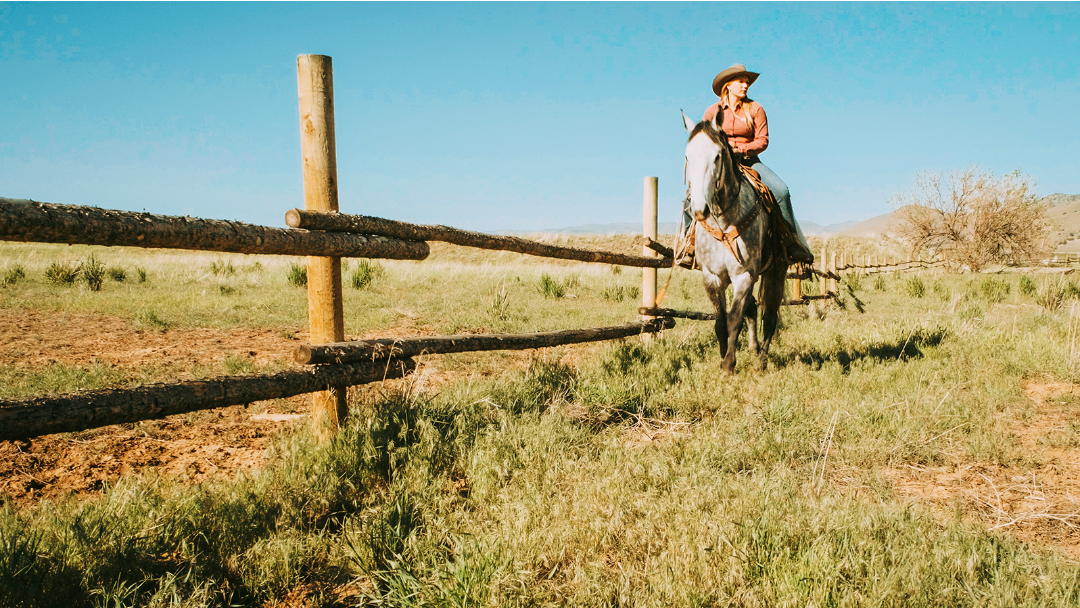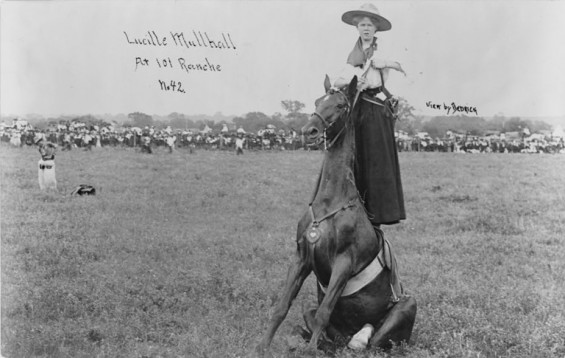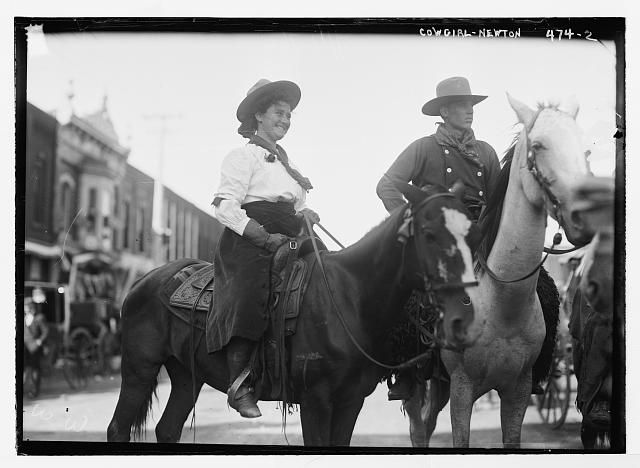
While their urban counterparts were restricted to more traditional female roles in the late 1800’s, women of the American West were roping and riding broncs. The term “cowgirl” first appeared in print by the early 1890s. Daughters of pioneer ranchers grew up riding and roping along with their brothers because on small ranches, everyone helped with the cattle. Attitudes of the day deemed it improper for a woman to dress and ride like a man, so many women wore full skirts and rode sidesaddle. During the Wild West shows, women first appeared as competitors with women like sharpshooter Annie Oakley, bronc rider Bertha Blancett, and steer-roper Mabel Strickland.
Due to social pressure, by the 1920’s the rodeo cowgirl was slowly replaced by the “ranch girl,” a predecessor to rodeo queens. Females began to ride alongside the singing cowboy and perform in pageants and horsemanship displays, rather than compete in events. Some early rodeo associations prohibited women from competing in events and often viewed them as “window dressing.”
Meanwhile, African American women were making significant contributions to the advancement and culture of the West by building towns, establishing charities, creating schools, and developing churches. Some carried out dangerous jobs such as delivering the mail. Former slave Mary Fields was the first female to deliver mail by stagecoach and was known for her fearlessness.

Photo: Wikimedia Commons
Foster Inquiry in the Classroom
Did you know that before she became the first female Supreme Court justice, Sandra Day O’Connor was a cowgirl who rode horses, shot guns and grew up on her family’s ranch in Arizona? Give your students the opportunity to research the life of this justice. Ask students and essential question to guide their inquiry skills like, “Why do you think stories of cowgirls have not been prevalent in movies and books?”
Have students research famous cowgirls:
- Annie Oakley, one of the best sharpshooters in her day who joined the famous Buffalo Bill’s Wild West Show; taught more than 15,000 women how to shoot and was an advocate of women’s rights
- Calamity Jane (Martha Jane Canary), well-known for knowing and potentially marrying Wild Bill Hickok; earned her nickname after working for the military and being engaged in numerous battles with the Native Americans; famous rider, sharpshooter and storyteller
- Belle Starr, notable American outlaw in the old west; known for being stylish and for riding sidesaddle with two pistols and dressed in black velvet; died in an ambush from fatal shot wounds, a murder that remains unsolved to this day
- Pearl Hart, Canadian outlaw who committed one of the last recorded stagecoach robberies in the American West
- Laura Bullion, known for being a member of Butch Cassidy’s Wild Bunch gang; involved in the Great Northern train robbery; known as “Della Rose”
- Eleanor Dumont (Madame Moustache), notorious gamblers during her time; opened a gambling parlor in Nevada City, where no women were allowed except herself
- Lottie Deno, notorious gambler, associated with other well-known Wild West characters, such as Doc Holliday; inspired the character of Miss Kitty Russell on the TV show Gunsmoke
- Mary Fields (Stagecoach Mary), notorious for drinking, smoking, and toting guns; first African American female star route mail carrier; never missed a day of work nor failed to deliver a letter
- Mamie Hafley (Elba Mae Ghent), famous for a high-diving horse act; rode her horse off a 50- foot tower into a 10-foot pool of water.
- Fox Hastings, trick rider; first and only woman to bulldog a steer
 Photo: Wikimedia Commons
Photo: Wikimedia Commons
Project-based Learning
There are many ways to teach your students about the contributions of cowgirls during the Western Expansion period in American history. Any of the suggestions below can be used as a journal entry or opportunity for student reflection, project-based activity where students work individually or in groups, or research paper.
- Cowboys came from all walks of life: soldiers from the Civil War unwilling to return home after the war, former slaves, criminals on the run from the law, former sailors, or the poor looking for work. Some folks came west just for adventure. Like most of society, there were good and bad cowboys/cowgirls. Ask students, “Why do you think the cowboy is perceived as the American icon—a champion of good? How are cowgirls perceived?”
- Cattle drives took place in summer and often lasted several months. Cowboys would wake early and work until early evening. On any given day, the cowboy may have to deal with a stampede, river crossing, extreme heat or cold, prairie fire or rattlesnake. Ask students, “Did women go on trail drives? Why or why not? What role might a woman play on a trail drive?”
- Ask students, “What role did cowboys play in winter?” Roundups and cattle drives were usually finished by November and cowboys often had to find other jobs until spring. Ask students, “What kind of job might a cowboy find? What did cowgirls do in winter?”
- An indispensable item in the Wild West was a gun, particularly a 45 Colt revolver. The most practical use was for hunting game, but it was also handy for shooting rattlesnakes or a horse if it had a broken leg and needed to be finished off. A gun fired in front of a stampeding herd might turn it away. Gunfights as portrayed by Hollywood movies almost never happened. Ask students, “What type of gun did Annie Oakley shoot? What other ways were guns used in the Wild West?”
Information on cowgirls is documented in historical records and children’s literature. Some books to use are:
- Fearless Mary: Mary Fields, American Stagecoach Drive
- Cowgirls: Women of the Wild West
- Little Miss Sure Shot: Annie Oakley’s World
- Lady Rode Bucking Horses: The Story of Fannie Sperry Steele, Woman of the West
- Who Was Annie Oakley?
- You Might Be a Cowgirl if…: A Guide to Life on the Range
- Wild Women and Tricky Ladies: Rodeo Cowgirls, Trick Riders, and Other Performing Women Who Made the West Wilder
- Cowgirl Up!: A History of Rodeo Women
- Wild West Women: Fifty Lives that Shaped the Frontier
- Cowgirls: Stories of Trick Riders, Sharpshooters and Untamed Women
- The Last of the Wild West Cowgirls: A True Story
Cowboys/cowgirls today go to college to learn the latest technologies to use in the cattle business. They can check on stock prices, get the weather forecast, determine the correct amount of feed to use, and communicate quickly with ranch hands through modern technology. While horses are still used, cowboys also use pick-up trucks, helicopters, and ATVs to get around. But the legacy of the Wild West still lingers in our minds. It is up to teachers to make sure that the diversity that existed is shared with students.
Seeking more professional learning resources?
See what our professional learning department can do for your teaching
Kay Gandy is a retired professor of seventeen years and a retired elementary teacher of twenty-seven years. Her goal is to work with teachers in countries around the world and watch movies in foreign theaters. Her books Mapping Is Elementary, My Dear and 50 Ways to Teach Social Studies (June 2021) provide practical lesson ideas for elementary teachers.
